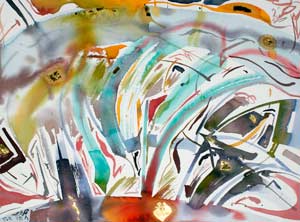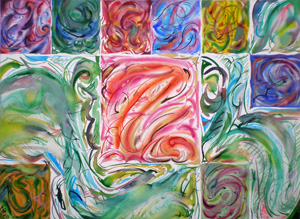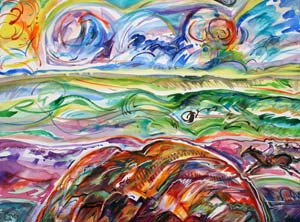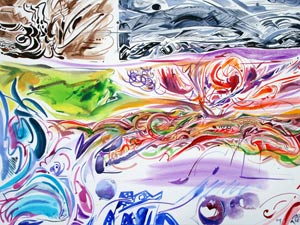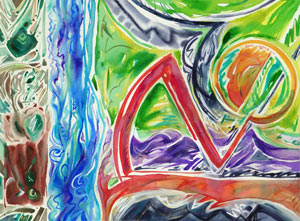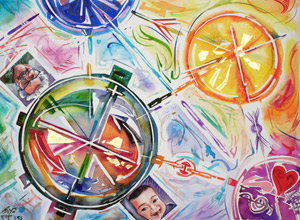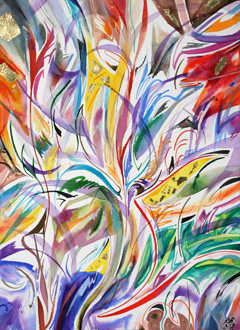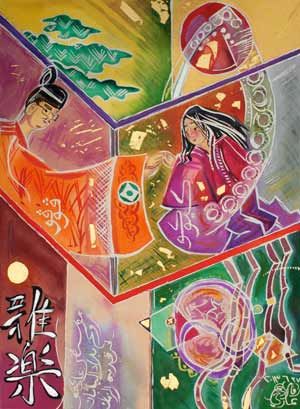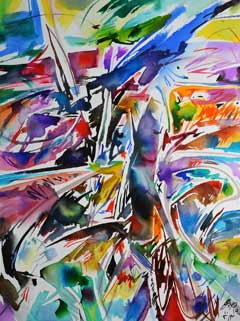PAINTING THE MUSIC
Vladimir Tamari
JANÁČEK
|
|
December 2011. I painted this picture listening once to Janáček's sprightly Sinfonietta. Quoting Wikipedia, this festive 1926 piece for a large orchestra was dedicated “...'To the Czechoslovak Armed Forces' and Janáček said it was intended to express 'contemporary free man, his spiritual beauty and joy, his strength, courage and determination to fight for victory.'” I came to know about this piece because it is an important motif in the book I was reading, Murakami's novel 1Q84. One of the protagonists, Aomame hears this piece in a Tokyo taxi and she is transported to a surrealistic parallel world where Tokyo had two moons. Aomame later researches the piece and finds that Janáček and his beloved “were walking in a park one day when they came across an outdoor concert and stopped to listen. Janáček felt a surge of joy go through his entire body, and the motif for his Sinfonietta came to him. Something seemed to snap in his head, he recounted years later, and he felt enveloped in ecstasy. By chance, he had been asked around that time to compose a fanfare for a major athletic event. The motif that came to him in the park and the motif of the fanfare became one, and Sinfonietta was born. The “small symphony” label is ordinary enough, but the structure is utterly nontraditional, combining the radiant brass of the festive fanfare with the gentle central European string ensemble to produce a unique mood.” I used gold foil to finish the painting. Not brass, but that is all I had in my studio :) Assorted associations and trivia: Aomame's taxi travels along a part of a Tokyo highway visible from my apartment stairway...A couple of days after finishing the painting, I witnessed the eerie December 10 total eclipse of the moon...For all my admiration of Murakami as a novelist, last year I signed a petition urging him not to accept the Jerusalem Prize – which he in fact accepted, giving a speech addressed to the assembled Israeli leaders about the lies of novelists vs. the lies of politicians... My relationship to the Czech armed forces is nil, but a few years back I needed an official photograph and was too lazy to wear my suit for it. Instead I photoshopped one from an online photo – an elegant suit worn by the Czech Minister of Defense!...In 1947 my uncle Alexander Debbas was the Czechoslovakian honorary consul in Jaffa when that country voted in the UN for the disastrous partition of Palestine. In protest he immediately resigned his post. |
BRAHMS (3)
|
March 2012. Brahms' Hungarian Dances! No. 5 is the best known of the 21 delightful and very popular pieces (originally composed for piano, but I listened to the orchestral version). So after dividing the panel into 21 rectangles I allocated the large central rectangle to it. Then, starting from the top left I painted a rectangle each while listening to the first six dances. Then during a video online chat my daughter Mariam saw the painting and said she disliked the format of small paintings-within-a-painting. Taking a hint, and considering her as one of my best critics, I painted in rectangles only to Dance No. 11 (blue, to the right), No. 16 (bottom left corner) and No. 20 (bottom right with burgundy brushstrokes). Finally while listening to the entire set a few times I painted the freely flowing greenish swirls in the remaining spaces, and toned down some of the original squares to suit the whole. The music is light-hearted and lively, but in several places it has a beautiful pensive tinge. That evanescent sadness tempers and elevates the Dances only as the genius of Brahms could do it. The set was completed in 1869 and became an instant success. In 1889 a representative of Thomas Edison took his recently invented phonograph to Vienna and recorded Brahms playing a short version of the first Dance on the piano. The recording, scratched on a cylinder covered with tin foil survives (you can hear it on YouTube!), but is of such poor quality the music is hardly recognizable. Nevertheless it is the first ever recording of music by a major composer!
|
TUVAN MUSC
|
June 2012. I first heard of Mongolian throat singing while reading a biography of the Nobel Prize winning American physicist Richard Feynman. Towards the end of his life, on a whim, he decided to travel to a land in Outer Mongolia that he knew the existence of from only an unusual stamp in his childhood collection. Overcoming many difficulties he made the journey to Tuva, then in the Soviet Union, and there heard the amazing throat singers whom he invited to perform in California. Throat singing is a unique and difficult vocal technique where both a sort of deep drone and a kind of whistling overtone are made simultaneously by the same singer. With this combination of sounds a variety of rhythmic and tonal combinations accompanied by simple instruments, exciting, haunting, funny, dreamy or very beautiful music is created. The Tuvans are a nomadic Turkic people who traditionally live in yurts (portable wooden structures) in a wild land of taiga (forested mountains and lakes) in Southern Siberia. I listened to many kinds of songs and instrumental pieces, mainly by the group Huun-Huur-Tu (try to hear them on YouTube). A male singer might start one song with a sustained bray or roar, and it can be quite hard to listen to, until magically, even while the roar continues, he goes into overtone mode and an ethereal undulating whistle is heard floating like an eagle in a clear sky. The lyrics of the singing that follows these vocal acrobatics in Tuvan, a language threatened with extinction, may well speak of eagles in the sky. The songs ranged from gutsy animistic chants, to fun-filled ballads about horses, bears and mythic happenings, to hypnotic Tibetan Buddhist chanting, to heartbreakingly beautiful mystical songs of longing, perhaps first sung from mountain tops to loved ones unseen out in the distant horizons. The musicality of the performers as to rhythm, tone and the ability to communicate mood is faultless. The music has a refreshing immediacy and primitive feel to it, although one hesitates to use the latter adjective for music so inventive and which employs such sophisticated vocal techniques. I tried to paint accordingly. |
KODÁLY
|
|
September 2012. For fifty years a piece of exuberant orchestral music by the Hungarian composer Zoltán Kodály was stuck in my head, and I recently found myself whistling the notes on my bicycle rounds of my area of Tokyo. It turned out that Kodály was a mentor of Béla Bartók, so that the music in my head (from the Háry János Suite) must have been on the reverse side of an LP vinyl record of Bartók's music I had as a youth in Ramallah. I started by painting to this Suite (purple-bluish area bottom right of the painting), and my original impression that Kodály's music was very enjoyable, but not 'great' was reinforced for a time by the next pieces I heard and painted to: Marozzsek Dances (lower left, in turquoise and indigo). Variations on Peacock folk song (Orange and violet area mid-upper right). With Night In the Mountains my opinion about Kodály started changing - the hypnotic high-pitched choral music unashamedly evocative of feelings of purity and joy was highly original (yellow green area). Dances of Galantia were quite nice, influenced at one point by one Brahms' Hungarian Dances (detailed strip middle right, in oranges, some green and yellow, and reds). By the time I discovered his Nine Pieces for Piano, Op. 3 (browns upper left corner), Four Italian Madrigals and the Sonata for Solo Cello Op. 8 (top, gray areas) my opinion of Zoltán Kodály was completely transformed. The Sonata for Solo (magnificently played by Henrik Dam Thomsen on YouTube) is one of the most beautiful, complex and thrilling 'new' pieces of music I have heard in a long time. Kodály is definitely one of the greats! |
SMETANA
|
October 2012
|
ORFF
|
January 2013 . Mona Saudi introduced me to Carl Orff's cantata Carmina Burana in Beirut when we were editing a book of drawings by Palestinian refugee children after the 1967 war. Now, 45 years after I first heard it I find that the music has not lost its freshness, vigor or sense of joyful release. |
VIVALDI (2)
|
April 2013. I first hard the CD of Vivaldi's Beatus Vir for small group of singers and orchestra around ten years ago at a friends' home where I was mourning my beloved father-in-law Seiichi Miyakoshi whose funeral I was unable to attend. The haunting angelic chorus of sopranos repeated as a refrain in Vivaldi's rendition of Psalm 112 ( numbered 111 during the composer's time) was a sorely needed comfort and tonic during that difficult time. The Psalm starts out with:
That refrain remained with me for many years and finally I rediscovered the piece on YouTube. I now started listening to this glorious music not in mourning but in circumstances summarized by the piece's Latin name Beatus Vir - Blessed is the Man. Almost daily news, photos and videos of the progress of our first grandchild - also named Seiichi - bring much happiness. On 7 April I used an iphone app to make a multi-layered graphic listening to this piece. And the day before I started the watercolor painting shown here, I had a wonderful reunion with a dear cousin and his family, after a separation of 43 years. This time round, Vivaldi's music with its intricate Baroque details and delightful precisely crafted passages was an expression of overflowing joy. Perhaps one measure of great music is that it allows the hearer to enjoy it fully at different levels and in contrasting moods. I just found out that there are two surviving versions of Vivaldi's Beatus Vir, but the one I like is catalogued as RV597 and RV 759. Version RV598 is much shorter and quite different but also beautiful, so I painted to that as well. Another realization is that the theme of of this text and painting dealing with sadness then with happiness, could summarize the emotions of the Christian Holy Week, from Good Friday to the joy of Easter Sunday.
|
GAGAKU (JAPANESE COURT MUSIC)
|
I first came across this music at a flea market in Kyoto, where I bought an old sho - the bamboo flute composed of many reeds bundled together unique to Gagaku. I would sometimes blow through it and enjoy the reedy kazoo-like notes that emerged - a sound not unlike that made by cicadas singing in unison on a hot summer day. Listening to the full 25 member orchestra playing gagaku is quite different from any musical experience I can think of. There is no singing, and the long steady high pitched chords create an intense wall of sound that reverberates inside one's head, repeated with subtle modulations. Occasionally there are pauses to let the drums or plucked stringed instruments punctuate the trance-like meditative mood, and prepare the listener for the next sustained phrase. As I listened to many types of Gagaku on YouTube, I painted in a style which is a tribute-cum-parody of the ancient scroll paintings illustrating the Genji Monogatari, (The tale of Genji) painted in shibui (sedate) earth colors. Written by Lady Murasaki (which means violet or purple) an 11th. c. noblewoman, the novel depicts life at court where no doubt gagaku music was played. The dark beige I used in the lower left is the beautiful color of the robe worn by a Japanese Emperor on his enthronement - I saw it on TV and still remember it. I added some Arabic text, labeling the man 'Vovo' - my childhood nickname - and the lady in violet 'Kyoko' as an affectionate tribute to my beloved Japanese wife of 46 years. She was not amused by the comparison with the feisty Lady Murasaki. |
FAURÉ
|
The Fauré Requiem well deserves its popularity - it is all of a piece, powerful and beautiful, always expressive and free from pretense or unnecessary embellishment. It very well might have been an expression of a deeply felt loss, but Fauré said "My Requiem wasn't written for anything – just for pleasure, if I may call it that!" I painted in a fever of excitement and finished the watercolor while listening to Fauré's lively Cello Sonata No. 2 Op. 117 and his Piano Quintet in C Minor Op. 115. Towards the end I briefly consulted a photo I had taken of a beautiful Japanese brush calligraphy I had seen at an exhibition the day before. The simple powerful strokes were of a basic Zen precept that could be translated as: "the power of now". The central vertical grayish stroke in my painting resembled that of the calligraphy. Indeed the painting was made in one continuous spontaneous 'now' session with no revision- pausing only to change the water in the container. I finished it, painting the final strokes, with my right hand holding a brush loaded with vermillion, whilst holding my trusty iphone with the left to take a video of the proceedings, music, color and all. Click here to see it on Youtube. |
